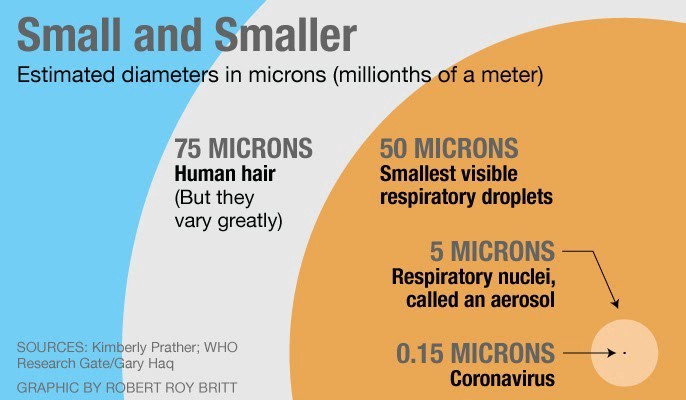
AFFIRMATION COMPLETE: Cloth masks cannot block smoke particles which are larger than viruses, so masks cannot stop virus transmission; “Wearing a cloth mask is close to pointless. A tiny virus can slip through your average bandana face covering like a mosquito flying through a chain link fence.”
REVIEW
Memes appeared on Facebook in late August 2020 claiming that cloth masks are ineffective at reducing virus transmission because smoke particles are larger than virus particles and cannot be filtered by cloth masks (see examples here and here). These memes were published following a U.S. Centers for Disease Control and Prevention (CDC) advisory warning people not to rely on cloth masks for protection against wildfire smoke. The advisory was published on Facebook on 31 August 2020 in response to the wildfires in California.
These memes echo many Facebook posts which appeared several months ago (see example) stating that the virus is smaller than pores in the fabric of cloth masks, likening it to “a mosquito flying through a chain link fence”. And based on the size difference, these posts claim that cloth masks do not work to reduce virus transmission. As we demonstrate below, these claims are misleading as they fail to take into account the differences between how viruses and smoke particles travel in the air.
While both smoke particles and the virus that causes COVID-19 (the size of the virus is between 60 to 140 nanometers)[1] are much smaller than the pores in fabric, a key difference between viruses and smoke particles is that viruses cannot travel in the air on their own and are instead carried by respiratory droplets. In a fact-check by USA Today, Linsey Marr, a professor of civil and environmental engineering at Virginia Tech who specializes in airborne transmission of viruses, stated, “There is never a naked virus floating in the air or released by people.”
In its advisory, the CDC also emphasizes the importance of respiratory droplets in virus transmission when explaining why cloth masks can reduce virus transmission, but not the inhalation of small smoke particles:
“Cloth masks that are used to slow the spread of COVID-19 by blocking respiratory droplets offer little protection against wildfire smoke. They do not catch small, harmful particles in smoke that can harm your health.”
Respiratory droplets are generated by coughing, sneezing, speaking, and singing. These droplets range from 5 to 10 micrometers in size and can be blocked by cloth masks. According to the World Health Organization, scientific evidence demonstrates that droplet transmission and close contact are the main routes of transmission of the virus that causes COVID-19. It is also possible that the virus is transmitted by aerosols, which are droplets less than 5 micrometers in size, although it’s unclear how much this mode of transmission contributes to the number of infections.

N95 masks are the most effective at filtering respiratory droplets. However the CDC advises the general public not to use N95 masks for slowing the spread of COVID-19, as these are in limited supply and should be reserved for healthcare professionals who are at greater risk of exposure to infectious material. Instead, the CDC recommends that the general public use cloth masks.
Studies show that cloth masks can reduce the spread of respiratory droplets, although they do not provide 100% protection. A 2020 study published in the New England Journal of Medicine found that wearing a damp washcloth greatly reduced the release of speech droplets into the air[2]. Another study published in ACS Nano found that well-fitted face masks made of common materials, such as cotton, filtered out 80 to 99% of droplets, depending on droplet size[3]. Studies also demonstrate that face masks can reduce the transmission of viruses that cause respiratory infections, as reported in this Health Feedback review.
However, for people with pre-existing respiratory issues, prolonged use of face masks, including cloth masks, should be exercised with caution. The CDC indicated, “Masks should not be worn by: children younger than 2 years old, anyone who has trouble breathing, or anyone who is unconscious, incapacitated, or otherwise unable to remove the mask without assistance.”
The recommendation to use cloth masks to reduce virus transmission contrasts with the CDC’s advice against using cloth masks for protection from wildfire smoke, because unlike the virus, smoke particles can travel in the air without the aid of another larger particle. This renders smoke particles small enough to pass through the pores of cloth masks.
Smoke contains a variety of particles that can cause asthma, chest pain, and other harmful effects on human health. The most damaging particles are those smaller than 2.5 micrometers, also called PM2.5. Luke Montrose, an assistant professor of community and environmental health at Boise State University, explained in this article in The Conversation:
“[PM2.5] defines the cutoff for particles that can travel deep into the lungs and cause the most damage.
The human body is equipped with natural defense mechanisms against particles bigger than PM2.5. As I tell my students, if you have ever coughed up phlegm or blown your nose after being around a campfire and discovered black or brown mucus in the tissue, you have witnessed these mechanisms firsthand.
The really small particles bypass these defenses and disturb the air [sacs] where oxygen crosses over into the blood. Fortunately, we have specialized immune cells present in the air [sacs] called macrophages. It’s their job to seek out foreign material and remove or destroy it. However, studies have shown that repeated exposure to elevated levels of wood smoke can suppress macrophages, leading to increases in lung inflammation.”
Because of these harmful effects, the CDC recommends that people living in areas affected by wildfires stay indoors as much as possible and use an indoor air filter. These recommendations are particularly important for vulnerable populations, such as the elderly and young children, who are living in the household. When outdoor activity cannot be avoided, the CDC recommended that people avoid wearing cloth masks, which are unable to keep out PM2.5. Instead, they recommend people wear N95 masks, which can filter out about 95% of particles that are 0.3 micrometers (microns) or larger.
In summary, while the Facebook posts and memes are correct in asserting that the pores in the fabric of cloth masks are larger than both the virus that causes COVID-19 and smoke particles, they fail to acknowledge the mechanics of virus transmission. The CDC’s advice not to use cloth masks as protection from wildfire smoke is not evidence that cloth masks do not work to reduce virus transmission. Unlike smoke particles, viruses cannot travel in the air on their own and must be carried by droplets, which are much larger than smoke particles and the pores in fabric, and can therefore be blocked by cloth masks.
REFERENCES
- 1 – Zhu et al. (2020) A Novel Coronavirus from Patients with Pneumonia in China, 2019. New England Journal of Medicine.
- 2 – Anfinrud et al. (2020) Visualizing Speech-Generated Oral Fluid Droplets with Laser Light Scattering. New England Journal of Medicine.
- 3 – Konda et al (2020) Aerosol Filtration Efficiency of Common Fabrics Used in Respiratory Cloth Masks. ACS Nano.
NOTES
This fact check is available at IFCN’s 2020 US Elections FactChat #Chatbot on WhatsApp. Click here, for more.



